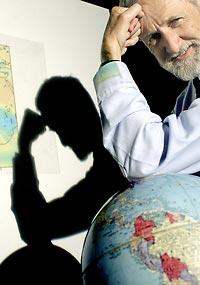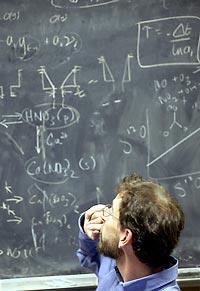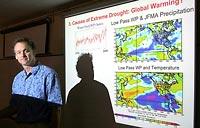Originally published October 9, 2005 at 12:00 AM | Page modified October 11, 2005 at 1:24 PM
The truth about global warming
Scientists overwhelmingly agree: The Earth is getting warmer at an alarming pace, and humans are the cause — no matter what the skeptics say.
Seattle Times staff reporter
John M. Wallace tried to steer Al Gore away from global warming.
The year was 1994 and the vice president was convinced rising temperatures were responsible for recent floods in the Mississippi River Valley.
He invited Wallace, a distinguished climate researcher from the University of Washington, to join a small group of scientists for a breakfast discussion in Washington, D.C.
As Gore sipped Diet Coke, Wallace nervously left the eggs on his own plate untouched.
"It was one of the more awkward audiences I've ever had," he recalled with a chuckle. "I was trying, in a polite way, to tell him he was coming on too strong about global warming."
Like many of his peers, Wallace wasn't convinced greenhouse gases were altering the world's climate, and he thought Gore was straining scientific credibility to score political points.
More than a decade later, Wallace still won't blame global warming for any specific heat wave, drought or flood — including the recent devastating hurricanes. But he no longer doubts the problem is real and the risks profound.
"With each passing year the evidence has gotten stronger — and is getting stronger still."
1995 was the hottest year on record until it was eclipsed by 1997 — then 1998, 2001, 2002, 2003 and 2004. Melting ice has driven Alaska Natives from seal-hunting areas used for generations. Glaciers around the globe are shrinking so rapidly many could disappear before the middle of the century.
As one study after another has pointed to carbon dioxide and other man-made emissions as the most plausible explanation, the cautious community of science has embraced an idea initially dismissed as far-fetched. The result is a convergence of opinion rarely seen in a profession where attacking each other's work is part of the process. Every major scientific body to examine the evidence has come to the same conclusion: The planet is getting hotter; man is to blame; and it's going to get worse.
"There's an overwhelming consensus among scientists," said UW climate researcher David Battisti, who also was dubious about early claims of greenhouse warming.
Yet the message doesn't seem to be getting through to the public and policy-makers.
Oklahoma Sen. James Inhofe, chairman of the Senate Environment and Public Works Committee, calls global warming "the greatest hoax ever perpetuated on the American people." Novelist Michael Crichton's "State of Fear" landed on the best-seller list this year by depicting global warming as a scare tactic of diabolical tree-huggers. A Gallup Poll in June found only about half of Americans believe the effects of global warming have already started.
At the G8 summit of world leaders this summer, President Bush acknowledged man is warming the planet. But he stood alone in opposition to mandatory emissions controls, which he called too costly.
"There's a huge disconnect between what professional scientists have studied and learned in the last 30 years, and what is out there in the popular culture," said Naomi Oreskes, a science historian at the University of California, San Diego.
Fuel companies contribute to that gap by supporting a small cadre of global-warming skeptics, whose views are widely disseminated by like-minded think tanks and Web sites.
Most scientists don't know how to communicate their complex results to the public. Others are scared off by the shrill political debate over the issue. So their work goes on largely unseen, and largely pointing toward a warmer future.
The consensus
Researcher finds that 1,000 studies all point to the same conclusion
Oreskes decided to quantify the extent of scientific agreement after a conversation with her hairdresser, who said she doesn't worry about global warming because scientists don't know what's going on.
"That made me wonder why there's this weird public perception of what's been happening in climate science," Oreskes said.
Preparing for climate change![]()
![]()
King County plans a one-day conference on climate change on Oct. 27 at the Qwest Field conference center. For information: http://dnr.metrokc.gov/dnrp/climate-change/conference-2005.htm
She analyzed 1,000 research papers on climate change selected randomly from those published between 1993 and 2003. The results were surprising: Not a single study explicitly rejected the idea that people are warming the planet.
That doesn't mean there aren't any. But it does mean the number must be small, since none showed up in a sample that represents about 10 percent of the body of research, Oreskes said.
The consensus is most clearly embodied in the reports of the 100-nation Intergovernmental Panel on Climate Change (IPCC), established by the United Nations in 1988. Every five to six years, the panel evaluates the science and issues voluminous reports reviewed by more than 2,000 scientists and every member government, including the United States.
The early reports reflected the squishy state of the science, but by 2001, the conclusion was unequivocal: "There is new and stronger evidence that most of the warming observed over the last 50 years is attributable to human activities."
A closer look
A world of evidence
A graphic view of how greenhouse gases are changing the world around us and what is to come.
Pollution's effects
From melting glaciers to disappearing islands.
Stunned by the strong language, the Bush administration asked the prestigious National Academy of Sciences to evaluate the international group's work. The UW's Wallace served on the academy's panel, which assured the president the IPCC wasn't exaggerating.
The next IPCC report is due in 2007. Among the new evidence it will include are the deepest ice cores ever drilled, which show carbon-dioxide levels are higher now than any time in the past 650,000 years.
In the history of science, no subject has been as meticulously reviewed and debated as global warming, said science historian Spencer Weart, author of "The Discovery of Global Warming" and director of the Center for History of Physics.
"The most important thing to realize is that most scientists didn't originally believe in global warming," he said. "They were dragged — reluctant step by step — by the facts."
A reluctant convert
Thawing Russian deer carcasses trigger scientific inquiry
Few were more reluctant converts than Wallace. A self-described weather nut who built a backyard meteorology station as a kid, he has spent his career trying to understand how the atmosphere behaves on a grand scale. By analyzing a decade of global climate records, Wallace was among the first to recognize El Niño's effects in the Pacific Northwest.
He was recruited to the UW's fledgling meteorology program in 1966 and has helped build it into one of the world's top centers for atmospheric and ocean research.
His first foray into climate change came in the early 1990s after Russian friends told him deer carcasses stored in their "Siberian freezer" — the porch — were thawing out.
Some scientists blamed global warming. Wallace examined the meteorological records and concluded natural wind shifts were blowing milder ocean air across the land.
He briefly thought he had debunked global warming.
Then he realized winds could account for only a small fraction of the warming in the planet's northernmost reaches, where average temperatures have now risen between 5 and 8 degrees in the past 50 years.
"It was an evolution in my thinking," said Wallace, 64. "Like it or not, I could see global warming was going to become quite a big issue."
That's pretty much how the science of global warming has progressed.
Researchers skeptical of the idea have suggested alternative causes for rising temperatures and carbon-dioxide levels. They've theorized about natural forces that might mitigate the effects of greenhouse gases. But no one has been able to explain it away.
"You would need to develop a Rube Goldberg-type of argument to say climate is not changing because of increasing carbon dioxide," said Battisti, 49, who directs the UW's Earth Initiative to apply science to environmental problems.
Global average air temperatures have risen about 1.2 degrees over the past century. The warming is also apparent in the oceans, in boreholes sunk deep in the ground, in thawing tundra and vanishing glaciers.
Earth's climate has swung from steamy to icy many times in the past, but scientists believe they know what triggered many of those fluctuations. Erupting volcanoes and slow ocean upwelling release carbon dioxide, which leads to warming. Mountain uplifting and continental drift expose new rock, which absorbs carbon dioxide and causes cooling. Periodic wobbles in the planet's orbit reduce sunlight and set off a feedback loop that results in ice ages.
All of those shifts happened over tens of thousands of years — and science shows none of them is happening now.
Instead, atmospheric levels of carbon dioxide are increasing at a rate that precisely tracks man's automotive and industrial emissions.
"The process is 1,000 times faster than nature can do it," Battisti said.
Climate reconstructions show that average global temperatures for the past 2 million years have never been more than 2 to 4 degrees higher than now. That means if greenhouse emissions continued unchecked, temperatures would likely be higher by the end of the century than any time since the human species evolved.
Skeptics often dominate discussion
Geochemist bridges the gap between science and popular perception
Eric Steig looks for answers about global warming in some of the Earth's most frigid spots. His walk-in freezers at the University of Washington are stacked with boxed ice cores from Antarctica and Greenland kept so cold he wears a parka and gloves to retrieve them.
Steig, a geochemist, analyzes air bubbles and isotopes in the ice to reconstruct past temperatures and carbon-dioxide levels. He planned a career in physics until an undergraduate field project on the Juneau glacier fields kindled his passion for snow and ice.
At 39, he belongs to a generation of climate researchers more open to global warming than the older guard, including Wallace and Battisti. Steig is also more frustrated by the way a handful of skeptics has dominated public debate.
"Many of us have felt our voices are drowned out by the very well-funded industry viewpoint."
He and several colleagues set out this year to bridge the gap between science and popular perception with a Web log called RealClimate.org. Researchers communicate directly with the public and debunk what they see as misinformation and misconceptions. By giving equal coverage to skeptics on the fringe of legitimate science, journalists fuel the perception that the field is racked with disagreement.
"You get the impression it's 50-50, when it's really 99-to-1," Steig said.
Over the past decade, coal and oil interests have funneled more than $1 million to about a dozen individual global-warming skeptics as part of an effort to "reposition global warming as theory rather than fact," according to industry memos first uncovered by former Boston Globe journalist Ross Gelbspan.
From 2001 to 2003, Exxon Mobile donated more than $6.5 million to organizations that attack mainstream climate science and oppose greenhouse-gas controls. These think tanks and advocacy groups issue reports, sponsor briefings and maintain Web sites that reach a far wider audience than scholarly climate journals.
Of course, there's nothing wrong with business questioning whether global-warming science justifies actions that may have profound economic impacts. And science can't advance without an open exchange of ideas.
But climate researchers say skeptics are recycling discredited arguments or selectively using data to make points. And as Oreskes showed, few skeptics publish in peer-reviewed journals, which check for accuracy and omissions.
Industry funds some skeptics
An Oregon climatologist finds a niche challenging global-warming science
Oregon State Climatologist George Taylor is a featured author on the Web site Tech Central Station, funded by Exxon and other corporations and described as the place where "free markets meet technology."
He has a master's degree in meteorology and runs a state office based at Oregon State University that compiles weather data and supplies it to policy- makers, farmers and other customers.
Related sites
Real Climate - scientists' blog
IPCC: Intergovernmental Panel on Climate Change
World Glacier Monitoring Service
American Geophysical Union position on global warming
The Discovery of Global Warming
National Academy of Science Report
Stephen Schneider, leading climate scientist
Skeptics
Taylor is not a member of OSU's academic faculty and has no published research on Arctic climate, but Sen. Inhofe cited Taylor's claim that Arctic temperatures were much warmer in the 1930s as proof global warming is bogus.
James Overland, a Seattle-based oceanographer who has studied the Arctic for nearly 40 years, analyzed temperatures across a wider area than Taylor. His conclusion: The 1930s were warm — but the 1990s were warmer. Two other peer-reviewed analyses agree.
Even more significant, Overland found the 1930s warming was typical of natural climate variation: Siberia might be warm one year and normal the next, while another part of the Arctic experienced unusual heat. Now there's persistent warming everywhere.
Taylor said in an e-mail that Tech Central Station paid him $500 for global-warming articles. United for Jobs, an industry coalition that opposes higher fuel-efficiency standards and greenhouse-gas limits, also paid Taylor and a co-author $4,000 for an article published on Tech Central Station.
Mainstream climate scientists, including Wallace, Steig and Battisti, generally get their research money from the federal government.
That doesn't make them immune from bias, said Patrick Michaels, one of the most widely quoted global-warming skeptics. Exaggerating the dangers of climate change can ensure a steady stream of money.
"Global warming competes with cancer and competes with AIDS for a finite amount of money," said Michaels, a University of Virginia climatologist and fellow of the libertarian Cato Institute. "Nobody ever won that fight by saying: My issue isn't important."
Michaels has received more than $165,000 in fuel-industry funding, including money from the coal industry to publish his own climate journal.
Skeptics portray themselves as Davids versus the Goliath of organized science, which is always resistant to new ideas. But global warming is the new idea, said Oreskes. Skeptics, she said, represent the old school of thought — that climate is so stable man could never tip it out of whack.
Climate models debated
But scientists say the uncertainty lies only in how much warming to expect
Battisti planned to run his grandparents' dairy farm in upstate New York until a persistent professor nudged him toward science. A study on beach formation got him excited about hands-on oceanography, then he switched to atmospheric sciences in graduate school.
He has analyzed some of the more cataclysmic climate-change scenarios, including the sudden shift depicted in the movie "The Day After Tomorrow," and concluded they're highly unlikely.
These days, Battisti ponders the Eocene, a period 35 million to 50 million years ago when alligators lived near the Arctic Circle and palm trees grew in Wyoming.
The world was hot because carbon-dioxide levels were three to five times higher than today — the result of a gradual buildup from volcanic eruptions. But global-climate computer models, which use mathematical formulas to represent complex atmospheric interactions, aren't able to reproduce that warming. When Battisti runs the models under Eocene-like conditions, they come up with much lower temperatures than actually existed — which means something was going on that scientists don't yet understand.
Models have improved greatly in the past 30 years but still can't anticipate all the ways the atmosphere will respond as greenhouse gases climb. The dozen models in use today predict average temperature increases of 3 to 11 degrees by the end of the century.
Though the numbers sound modest, it took only a 10-degree drop to encase much of North America in mile-deep glaciers during the ice age that ended about 12,000 years ago.
Skeptics point to uncertainties in the models and conclude the actual temperature changes will be lower than the predictions. Battisti points to the Eocene and warns that unknown factors could just as easily make things worse.
Could the skeptics be right, and the majority of the world's experts wrong?
The history of science shows consensus doesn't guarantee success. The collective wisdom of the early 1900s declared continental drift bunk. Some Nobel laureates attacked Einstein's theory of relativity.
Those blunders occurred when science was less sophisticated and connected than it is now, said Weart, the historian. With the unprecedented study devoted to climate change, the odds that this consensus is wrong are slim, he added.
"The fact that so many scientists think it's likely a truck is heading for us means that the last thing we want to do is close our eyes and lie down in the road."
Sandi Doughton: 206-464-2491
UPDATE - 10:01 AM
Rebels tighten hold on Libya oil port
UPDATE - 09:29 AM
Reality leads US to temper its tough talk on Libya
UPDATE - 09:38 AM
2 Ark. injection wells may be closed amid quakes
Armed guards save Dutch couple from Somali pirates
Navy to release lewd video investigation findings
More Nation & World headlines...
![]()

Entertainment | Top Video | World | Offbeat Video | Sci-Tech
general classifieds
Garage & estate salesFurniture & home furnishings
Electronics
just listed
More listings
POST A FREE LISTING







